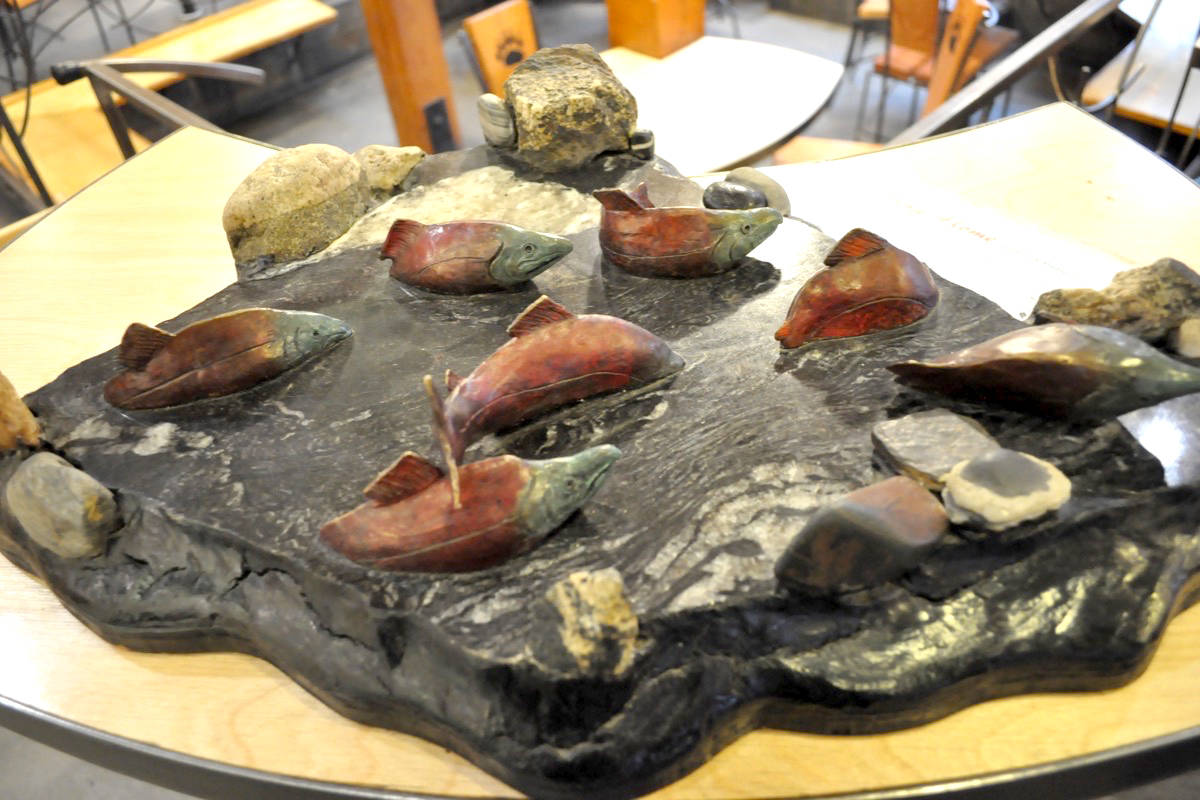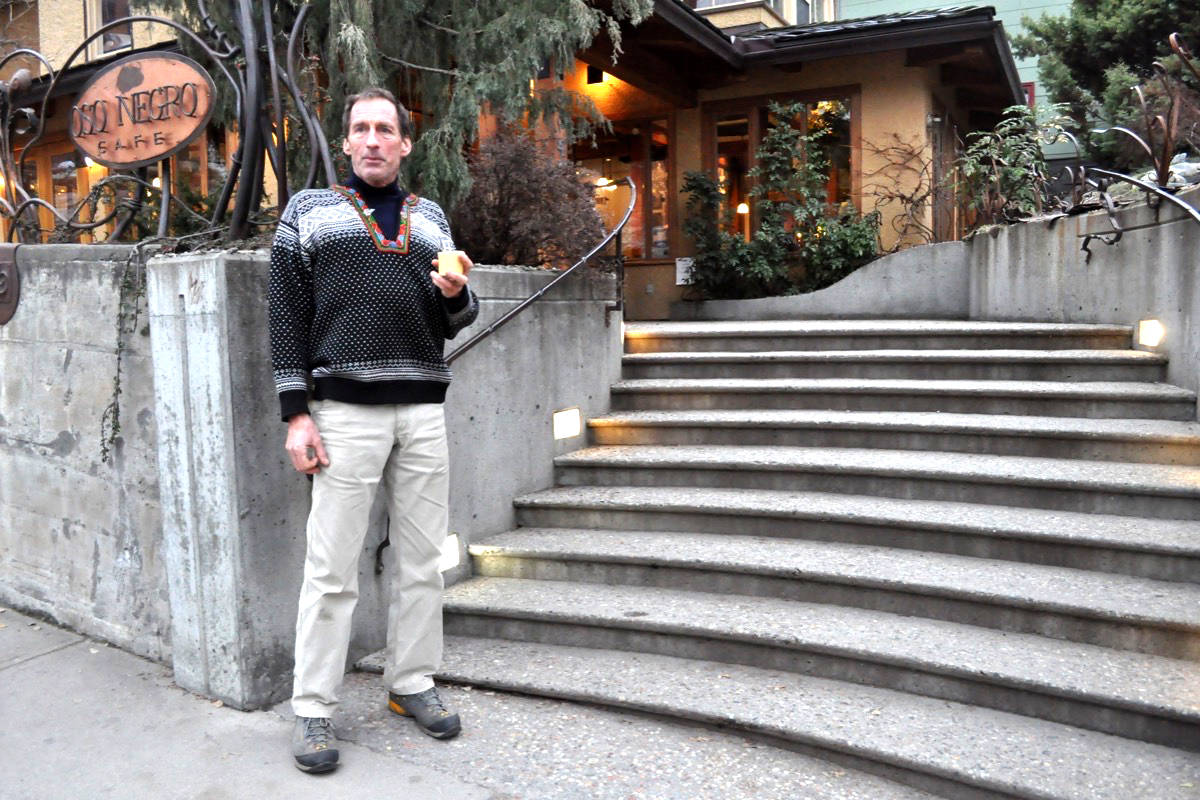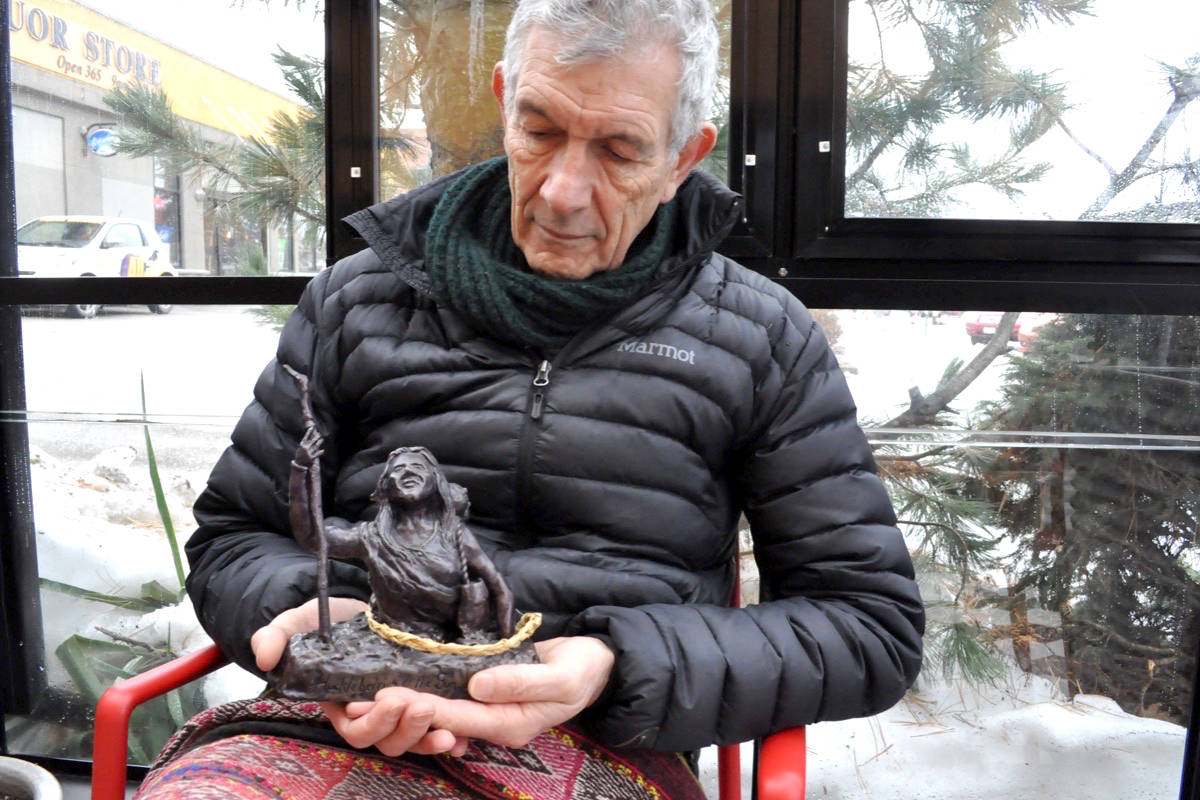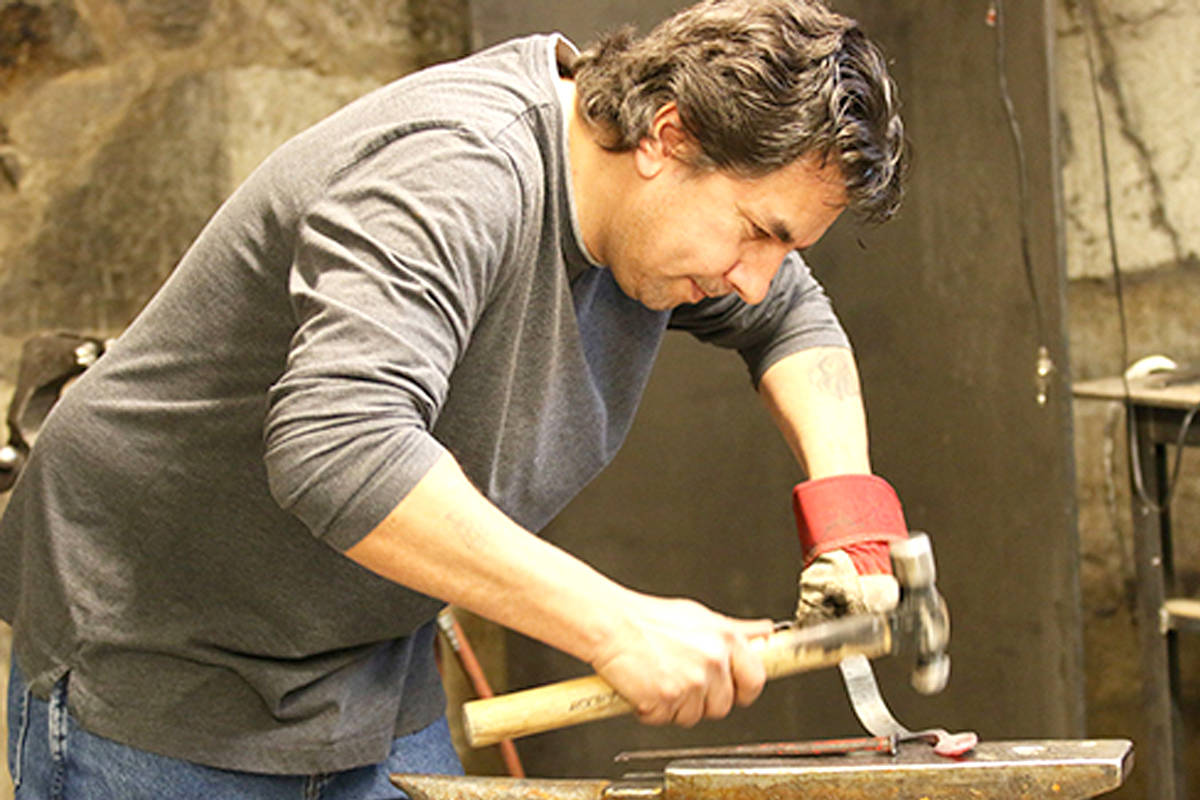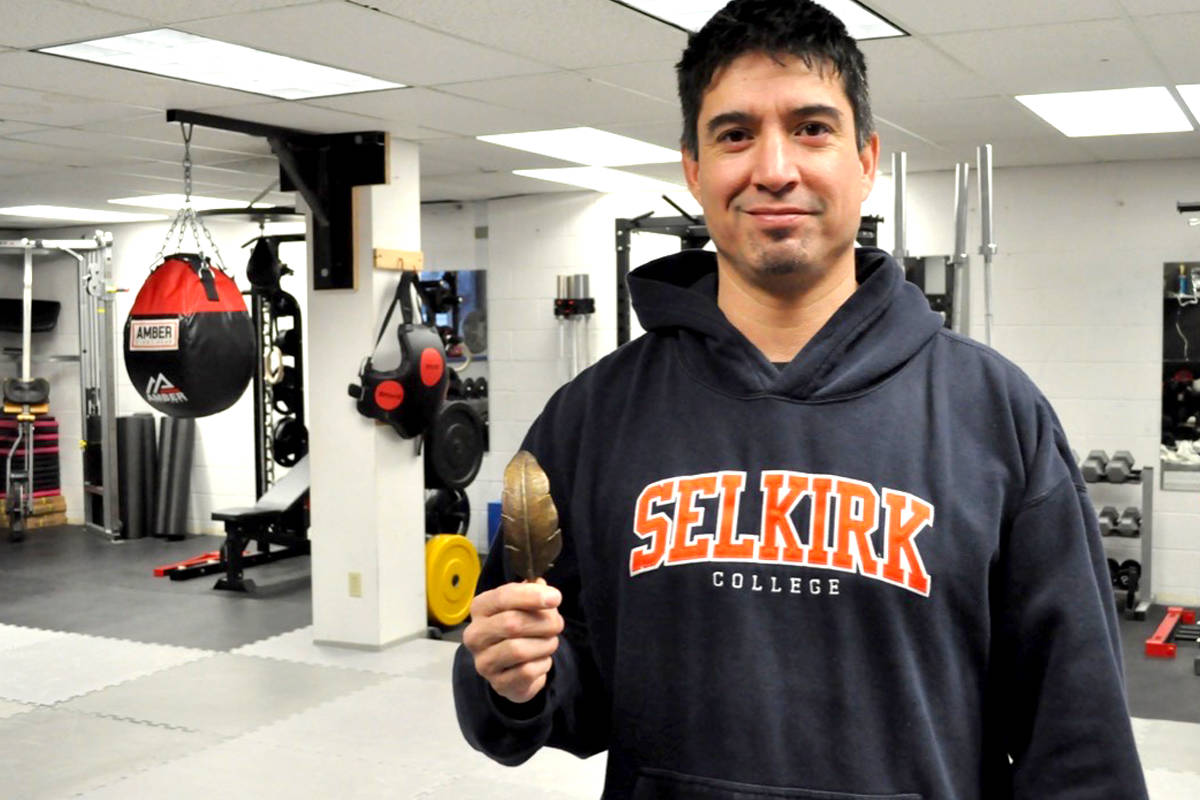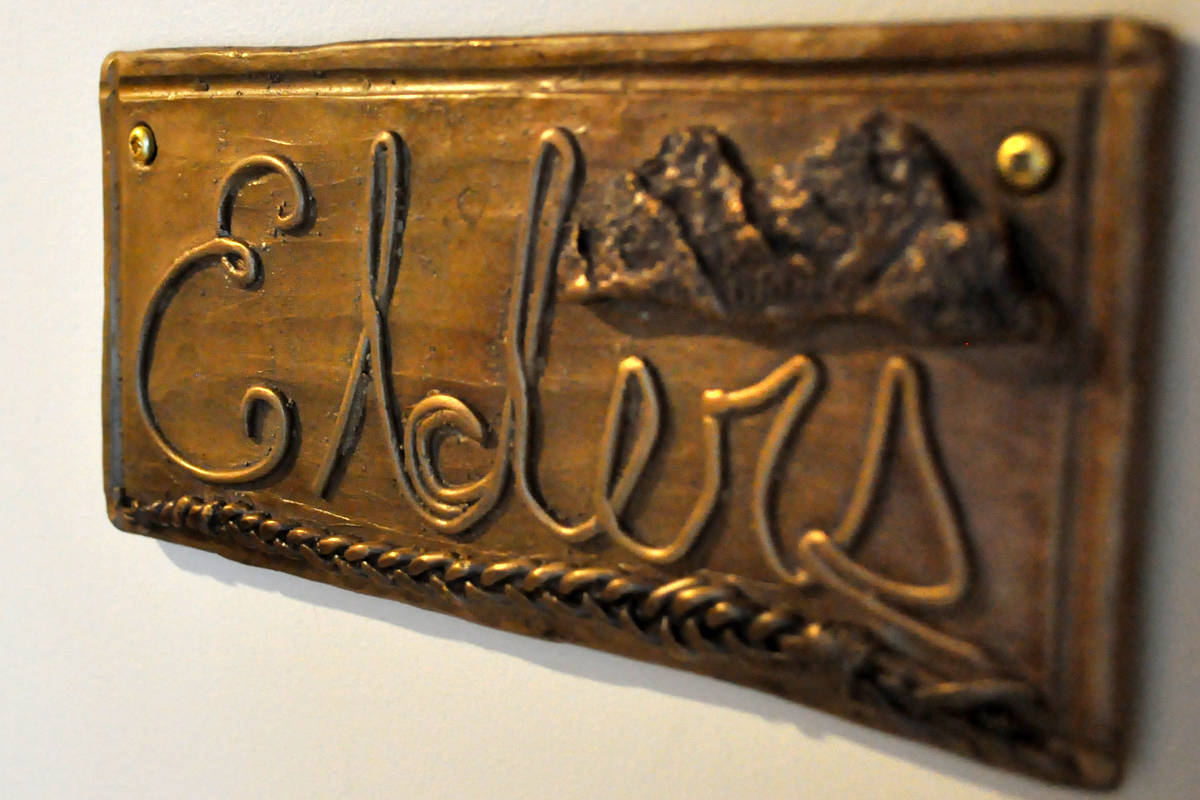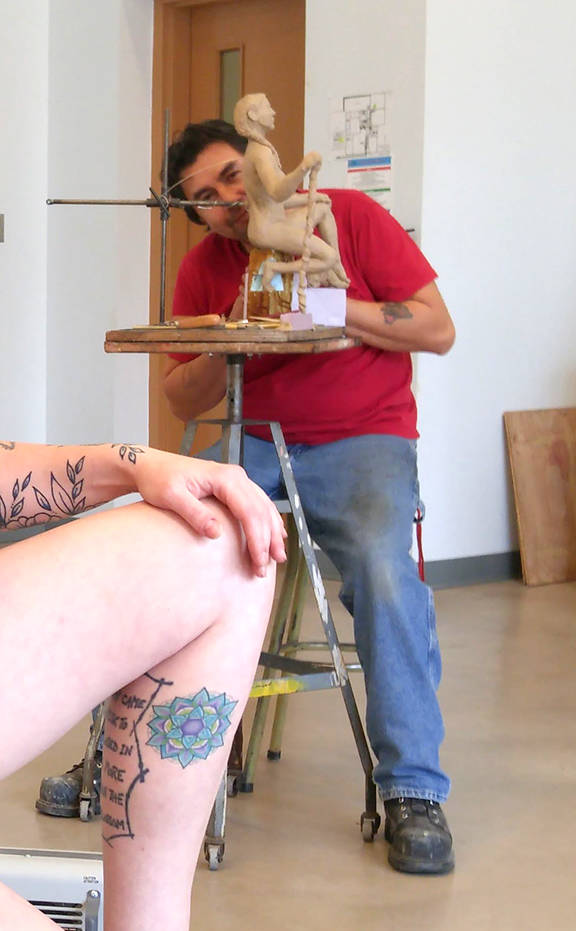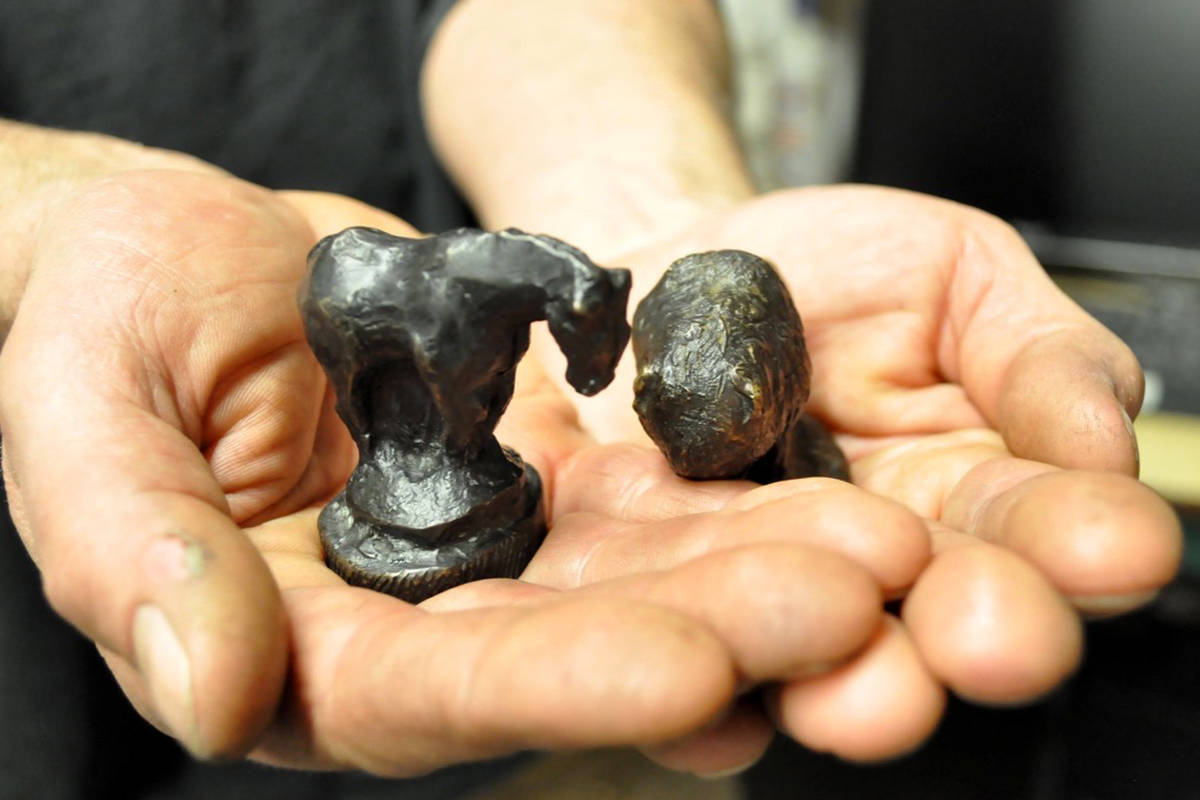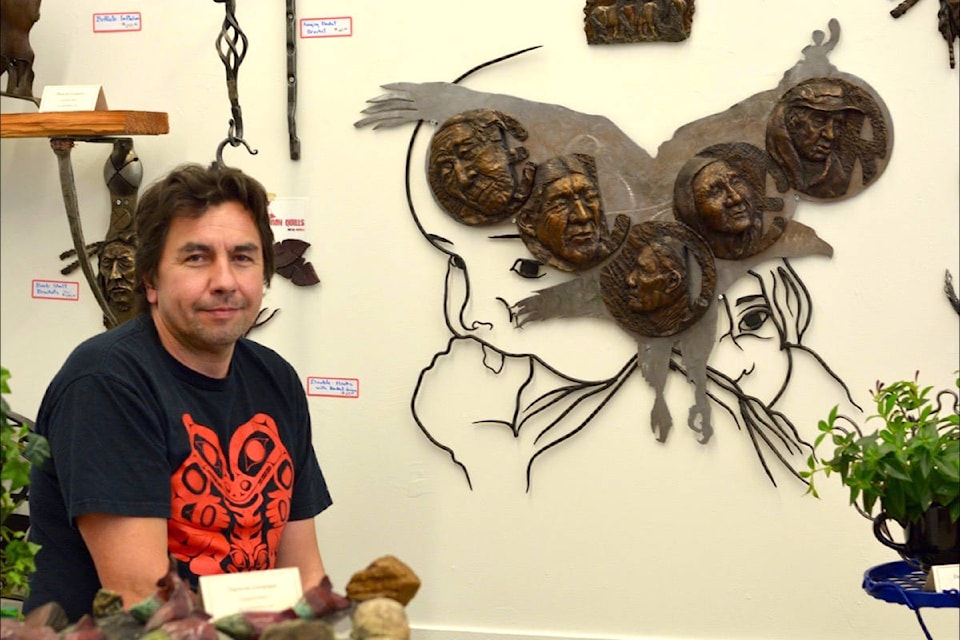The Kokanee salmon caught his eye.
Six bronze fish struggling to swim upstream in a river of marble surrounded by inset stones. A piece so exquisite, so perfectly representative of life in the Kootenays, that when Jon Meyer saw it at a local art show he knew he had to have it. Then he saw the price tag and was aghast.
The artist had already sold it for $360. Meyer couldn’t believe it. This piece, he thought, would sell in a bigger city like Vancouver for perhaps as much as $6,000. Meyer pleaded with the artist to increase the price. If the buyer returned so be it, but Meyer would pay far more.
Meyer returned the next day to find the salmon still available. He ended up convincing the artist, who he had been friends with for over a decade, to take approximately $900 for it.
Nearly two years later, Meyer says he thinks Darwin Greyeyes was completely aware how much the salmon could have sold for. “He knew, he didn’t care,” says Meyer. “The value was in the production, the creation.”
Today there are precious few examples of Greyeyes’ art on display. Greyeyes disappeared without a trace last June, shortly after giving away most of the work he’d completed in a short but prolific period in which he rediscovered his own astonishing artistic talent.
The salmon, however, remain. Meyer, who owns the local coffee shop Oso Negro, gave the fish their own permanent place of honour in the cafe. Greyeyes’ last touch on the piece was to give it a name. He called it “Going Home.”
***
Kevin Kratz stresses he isn’t exaggerating when he says Darwin Greyeyes was his best student in 15 years of teaching blacksmithing.
Greyeyes enrolled in Kratz’s class for the 2015 fall semester at Nelson’s Kootenay Studio Arts at Selkirk College. Then already in his 50s, Greyeyes stood out among his far younger students. He was quiet and kept to himself, but was also willing to help others.
It was his talent, though, that immediately impressed Kratz. Generally, Kratz’s favourite students are the ones willing to fail several times on a project until they get it right. That didn’t apply to Greyeyes.
“Darwin didn’t go through as many failures as most of us do,” says Kratz. “He pretty much nailed it on the first or second try. But you really need to practice and that was one of the things he loved doing, was being in here working.”
Greyeyes was meticulous in everything he did. He had the hands for blacksmithing and bronze casting after spending 30 years in construction, and put as much effort into making his tools as he did with his sculptures.
He also wasn’t starting from square one. Greyeyes had previously sold and taught stained glass art for five years before leaving the arts for over two decades to work and help raise his three daughters.
In a May 2016 interview Greyeyes did with Selkirk College, he described how terrified he’d been returning to art.
“I didn’t even doodle or anything,” he said. “It was like I closed that door. And I was OK with it. I was happy to be a dad and just working hard, but now that the door is open again, it’s like the flood gates. I love it. It is part of my healing.”
His art, which often reflected his Plains Cree heritage, was so good that the college commissioned him to make ornate furnishings for the Aboriginal Gathering Place at its Castlegar campus, as well as 21 bronze feathers given as gifts to its Indigenous graduates.
At the same show he sold the salmon to Meyer, Greyeyes told a Star reporter he was finding what he referred to as his aboriginal voice. “I want to present it in a way that is not beating people over the head with it, but just so people get the feeling,” he said. “One of my pieces today made a lady cry, which is what I want to evoke.”
Greyeyes also bonded with Kratz. In the summer of 2016, Kratz asked Greyeyes to spend a weekend with him in Nakusp working as blacksmiths at a Society For Creative Anachronism event. Unaware they needed to be wearing period-appropriate clothing, the pair spent their time fixing armour for knights and making jokes about the surreal setting.
“We were like a couple of school kids,” says Kratz. “We giggled the whole way there. ‘We’re going to this medieval fair, maybe we’ll see some maidens.’ That kind of goofy boy stuff.”
All that Kratz has left of Greyeyes now are memories and two small figures of a horse and bison his student gifted him. Greyeyes completed the initial 10-month sculptural metal certificate and enrolled to continue his studies in the fall of 2016.
When he returned to Kratz’s class, however, something in Greyeyes had changed. He’d suffered from anxiety and was diagnosed with bipolar disorder in 2014. But Kratz said Greyeyes also struggled with the medications he was on, and that he only lasted about a month into his second year of studies before dropping out.
Before his departure, Greyeyes told Kratz he’d lost his drive to make art. In retrospect, Kratz says he wasn’t surprised by Greyeyes’ disappearance, and wishes he could have done more for his friend.
“I think I was the only guy he let give him a hug.”
***
Greyeyes was last seen at a local business on June 4, 2017, but wasn’t reported missing for another 17 days.
When police searched his apartment at Anderson Gardens, they found his personal belongings, including his keys, wallet and cellphone, had been left behind. Sgt. Dan Markevich, a 12-year veteran of the Nelson Police Department, says Greyeyes wasn’t working at the time but had a list of things he wanted to accomplish that summer, including volunteer work and taking part in an art show.
Markevich admits he’s hit a roadblock in the search for Greyeyes, who left behind no clues of where he might have voluntarily, or involuntarily, disappeared to. “He didn’t give any direction on what he might be doing, where he might be going, anything like that,” said Markevich.
If someone in Nelson wants to vanish, it’s easy to do so. Kootenay Lake is big enough to make searches difficult, and the forest surrounding the city is equally vast.
To illustrate that point, Markevich recalls a case six or seven years ago of a 16-year-old boy who’d gone missing. Police searched for two weeks and came up empty, only for the teen to come out of hiding despite staying in a homeless camp that had already been canvassed. “So yeah,” Markevich says, “it’s pretty easy.”
Further complicating the search is that Greyeyes was living alone in Nelson. He has no family in the area — his ex-wife, who declined to be interviewed for this story, and his daughters live outside the Kootenays — and he also had an arms-length relationship with those who raised him.
Greyeyes grew up with nine other siblings in Marcelin, Sask., a small community north of Saskatoon in the Muskeg Lake Cree Nation. His parents and three older siblings attended St. Michael’s Indian Residential School, which traumatized the family.
In his interview with Selkirk College, Greyeyes said he had repressed memories of a difficult childhood.
“Residential schools destroyed the family system. Us 10 kids were raised never knowing what affection was,” Greyeyes said. “We couldn’t communicate with each other because we didn’t know how.”
***
Fragments of Greyeyes remain throughout the city.
In 1999, Greyeyes and his family moved to Nelson where he started working for Cam Mathieson’s construction company. Mathieson’s injured shoulder necessitated the hire, and he quickly came to trust Greyeyes. The pair revelled in on-the-job problem solving as a creative outlet.
“We were both in the same situation,” says Mathieson. “We both lived before kids as artists and then you get a mortgage and you try to keep that little flame alive.”
Greyeyes worked for Mathieson until 2007. One of their biggest projects was the construction of several buildings and a gymnasium at the Nelson Waldorf School between 2000 to 2003. That work was funded by a job creation grant, and Mathieson put Greyeyes in charge of a crew with no prior construction experience. “These jobs all got done with really one person who knew what they were doing,” recalls Mathieson.
Greyeyes also had a special gift for working with concrete. In 2003, Jon Meyer was renovating the land that would become Oso Negro’s new home but ran into a problem with the plans for curved stairs leading up from the street to the cafe. Meyer knew how he wanted them to look, but had no idea how to install them.
He was eventually recommended Greyeyes, who initially turned him down for lack of time. But Meyer persisted.
“Within a week he arrived with his belt on, which was a godsend because I had no idea what I was up against,” says Meyer. “I was just being ignorant and brutish and it would have been a mess.”
Meyer spent a little time describing what he wanted as Greyeyes stood and listened quietly. Then he got to work.
The beauty of the finished product, which is walked over by hundreds of people each day at the popular spot, is by its nature easy to overlook. But Meyer still speaks in awe of the stairs, something he’d envisioned but couldn’t realize without Greyeyes.
Greyeyes also brought creativity to more mundane projects. In 2007 he was tasked with being the lead carpenter for Terence Buie’s house and later a pair of greenhouses. In that time he became friends with Buie.
Buie has two pieces of Greyeyes’ art. One is a bust of a woman with a baby on her back called “Huckleberries and the sun at my back.” The other, Buie likes to joke, is his house.
“His presence is there,” says Buie. “He’s very much on that land and there were times when he came up just to be there. If I wasn’t around I would say, ‘Darwin, feel comfortable to come there and be on the land.’”
Reconciling Greyeyes’ disappearance has proven difficult for the people who still live with his work every day. He’s gone and he’s not, he’s past and present, he was and he is.
“I don’t see him but he’s still here. I don’t drive by Anderson Gardens without thinking…,” Buie says before his voice fails to finish the thought.
***
The first Greyeyes art Tamara Morgan saw was technically a failure.
Morgan, a blacksmith and artist herself, is a regular at Kootenay Studio Arts. Although she graduated in 2006, she still drops in occasionally to give talks and check on what students are doing.
Once she arrived to find Greyeyes working on what was supposed to be a belt buckle. He’d made two old hands holding a cane, a piece that was far too large to work as a buckle but stunned Morgan for its detail. She still swoons thinking about it.
“The advantage he took of the clay to make every knuckle wrinkle, and it wasn’t smooth hands, it was an old farmer’s working hands,” she says. “The nail beds, the cuticles, the wrinkles between the knuckles.”
Morgan and Greyeyes slowly bonded, mostly at Morgan’s insistence. He was reserved and humble. She was energetic and boisterous. They were an odd pair, but had a mutual love for craft and creation.
They also shared the same demons. Morgan suffers from social anxiety, and found Greyeyes was willing to open up to her about his health in a way he wouldn’t with others. Once he did, she made a point of regularly asking for updates.
“You had to massage conversations with him,” says Morgan. “There was an art of communicating with him where he would respond to questions, and if you asked the right ones he would share. But I think vulnerability was really, really hard for him and not safe. I think when you feel like you’re crazy, it doesn’t make you feel like you can relate to other people.”
Not all their talks were about mental health. They spoke about their kids and art and as she thinks about him now she remembers the embarrassed grin he wore one day while she posed nude for his class.
In the months prior to his disappearance, Greyeyes gave away the art he didn’t sell. Hindsight being what it is, Morgan only now sees that as a red flag. But there were other signs as well.
Meyer received a long email from Greyeyes in January 2017. His friend spelled out what was going on, but Meyer thought Greyeyes was just going through a cycle. Now, he says, he feels guilt every day for doing nothing.
Greyeyes also previously reached out to Mathieson in the fall of 2016. Mathieson decided to take his friend on a trip to Duncan Lake.
“I thought with Darwin, we could go and get a piece of wood together, spend a day in the wilderness together and then make a light. …,” says Mathieson. “Metaphorically and tangibly it worked as a good symbol. We went and got the piece of wood, but then it never happened just because both our lives didn’t mesh.”
Mathieson still has the piece of wood he planned to work on Greyeyes. He ran into Greyeyes on the street on June 2, and Greyeyes told him how poor his health was. The pair made plans to return to Duncan Lake. Greyeyes was last seen two days later.
Recently, Buie dreamt about Greyeyes. They were at a party. As people danced around them, Buie felt as though Greyeyes wanted to leave. “I didn’t see him, it was as if he was withdrawing,” says Buie. “I left and it was like I was following that energy.”
When he woke up, Buie was alone in the house Greyeyes had built. Wherever Greyeyes had gone, Buie’s offer still stood: his friend could always come back home.
tyler.harper@nelsonstar.com
Like us on Facebook and follow us on Twitter
